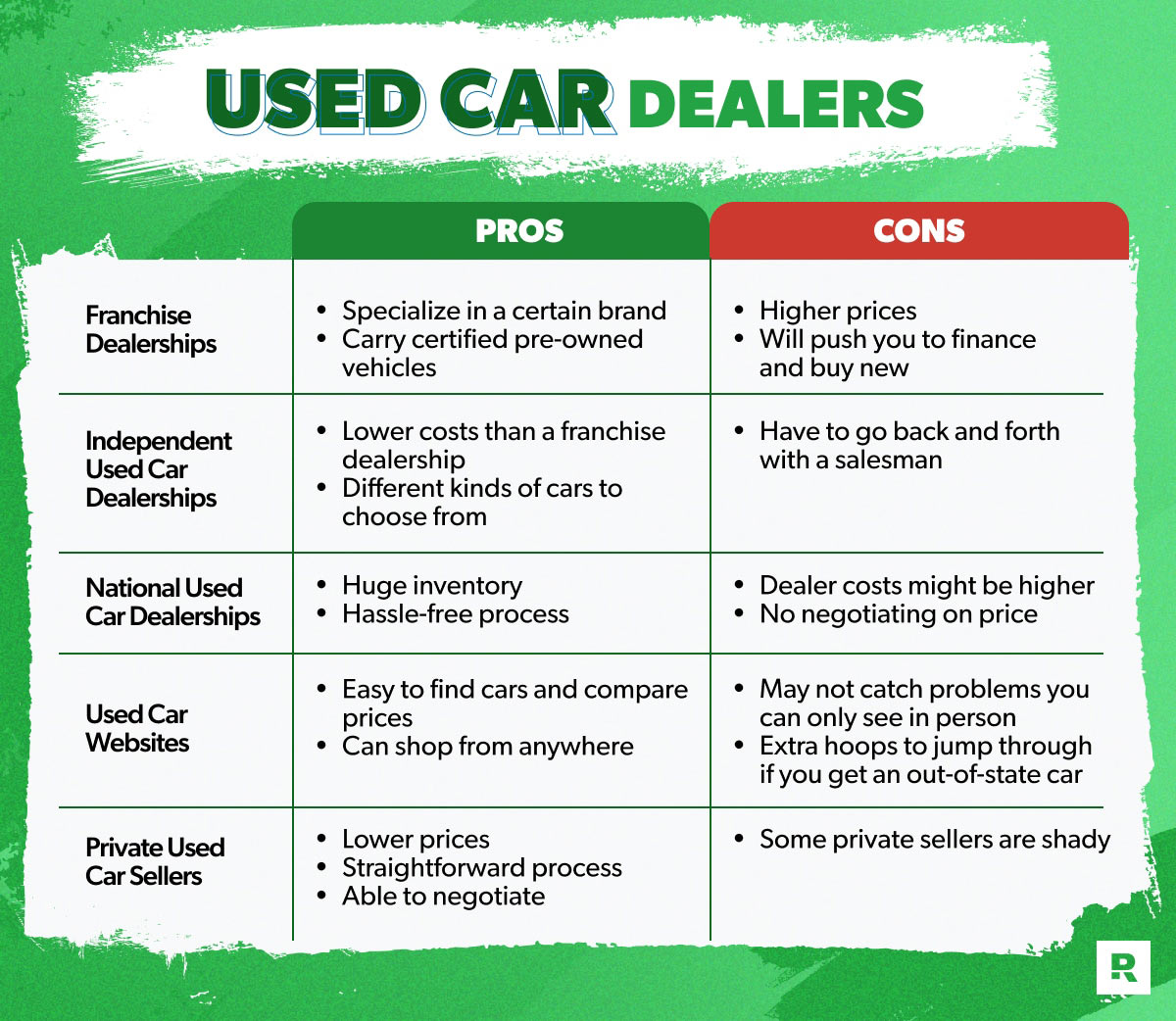Researching Used Car Markets
Navigating the used car market can be daunting. Understanding the diverse landscape of online and offline platforms is crucial for making informed decisions. This involves evaluating various sellers, from reputable dealerships to individual private sellers, and critically assessing their offerings to find the best value. The availability of information and transparency of pricing varies considerably across different channels.
Thorough research empowers buyers to compare options effectively, identify potential risks, and ultimately secure a suitable used vehicle. By examining the strengths and weaknesses of each platform, buyers can optimize their search strategy, reducing the likelihood of costly mistakes.
Online Used Car Marketplaces
Various online platforms cater to the used car market, each with its own strengths and weaknesses. Understanding these nuances allows buyers to make informed choices based on their individual needs and preferences. These platforms offer convenience and potentially wider selection, but transparency and seller reliability can vary.
- Dealerships: Dealerships often provide a structured environment, offering warranties, financing options, and the potential for inspection and service. However, prices might be higher than from private sellers, and negotiations may be limited. The structured process can ease concerns about vehicle history and condition. A buyer can expect more detailed documentation and potentially more comprehensive service options.
- Private Sellers: Private sellers can offer competitive prices, allowing for potentially more flexibility in negotiations. However, buyers are responsible for verifying the vehicle’s condition, history, and legitimacy. The buyer needs to be vigilant about potentially hidden issues and must conduct thorough research and verification.
- Online Auctions: Online auctions provide an opportunity to potentially find significantly discounted vehicles. The competitive bidding process can result in substantial savings, but the lack of direct interaction and the possibility of undisclosed issues require careful consideration. A potential drawback is the often limited seller information and potentially less detailed vehicle history.
Factors to Consider When Choosing a Platform
Several factors influence the optimal platform for a used car purchase. Assessing these elements ensures a smooth and satisfactory transaction.
- Reputation and Reviews: A platform’s reputation and customer reviews offer valuable insights into the reliability and transparency of transactions. Positive reviews suggest a higher likelihood of a successful purchase, while negative feedback signals potential issues.
- Pricing Transparency: Clear and transparent pricing is essential for informed comparisons. Hidden fees or inflated prices can lead to unexpected costs. The more transparent the pricing, the better the potential for a fair deal.
- Customer Service: Responsive and helpful customer service is invaluable, particularly in resolving issues or answering questions. Effective customer service can greatly enhance the buyer’s experience.
Comparison of Popular Online Marketplaces
The following table compares three prominent online used car marketplaces, highlighting key features.
| Platform Name | Average Price Range | Seller Type | Customer Service Rating |
|---|---|---|---|
| Carvana | $10,000 – $25,000 | Dealership | 4.2/5 stars (based on user reviews) |
| Autotrader | $5,000 – $20,000 | Dealerships & Private Sellers | 4.0/5 stars (based on user reviews) |
| Carfax | $8,000 – $22,000 | Dealerships & Private Sellers | 3.8/5 stars (based on user reviews) |
Note: Average price ranges and customer service ratings are estimates based on publicly available data. Individual experiences may vary.
Evaluating Used Car Listings
Thorough research is crucial for a successful used car purchase. Beyond identifying potential dealerships or online marketplaces, evaluating used car listings themselves is equally vital. This involves scrutinizing the details provided and asking clarifying questions to ensure the car aligns with your needs and expectations.
Understanding the information presented in used car listings is critical for making an informed decision. A well-researched listing often reveals key indicators of a vehicle’s condition, history, and potential issues. This meticulous review helps prevent costly surprises and ensures a transparent transaction.
Importance of Thorough Inspection
A comprehensive evaluation of used car listings is essential to prevent costly mistakes. A superficial review can lead to overlooking critical details, potentially resulting in the purchase of a vehicle with hidden issues. This meticulous process allows you to identify potential problems early on and negotiate a fair price based on the vehicle’s true condition.
Key Elements to Look For
Examining crucial details within used car advertisements is vital. Mileage, condition descriptions, and any mention of prior accidents are key indicators. The clarity and completeness of these details often suggest the seller’s transparency and the vehicle’s history.
- Mileage: High mileage, especially in relation to the car’s age and model, might indicate higher wear and tear. A sudden significant jump in mileage between listings could signal a potential issue.
- Condition Description: Detailed descriptions are essential. Vague or overly positive descriptions should raise suspicion. Look for specific details about the car’s exterior, interior, and mechanical components.
- Accident History: Explicit mention of accidents, repairs, or damage is vital. Knowing about past incidents allows for a more informed assessment of the vehicle’s current condition and potential future maintenance needs.
Questions to Ask a Seller
Direct communication with the seller is crucial. Proactive questions can unveil hidden information, potentially leading to a better understanding of the vehicle’s history and condition.
- Accident History: “Has this vehicle been involved in any accidents?” or “Are there any records of repairs following an accident?”
- Maintenance Records: “Are there any maintenance records available?” or “Have all scheduled maintenance procedures been performed?”
- Modifications: “Has the vehicle undergone any modifications or aftermarket installations?”
- Reason for Sale: “What is the reason for selling the vehicle?”
Essential Criteria for Evaluating a Listing
A structured evaluation using key criteria is crucial for efficient assessment. This table Artikels these elements, aiding in a systematic approach.
| Criteria | Description Examples | Suggested Actions |
|---|---|---|
| Mileage | “100,000 miles,” “200,000 miles with documented maintenance,” “high mileage with unknown history” | Request more details, decline if excessive and unexplained |
| Accident History | “Minor fender bender,” “Total loss with full repair,” “No accident history” | Request detailed accident report or photos, decline if unclear |
| Condition | “Excellent condition,” “Minor cosmetic flaws,” “Significant damage visible” | Request additional photos, detailed inspection |
| Maintenance Records | “Regular service records available,” “No service records available,” “Records show all scheduled maintenance” | Request records, decline if no records exist |
| Mechanical Issues | “Runs smoothly,” “Needs new tires,” “Engine light illuminated” | Request a test drive, decline if serious mechanical issues are reported |
Understanding Car Condition and History

Knowing the complete history of a used car is crucial for making an informed purchase decision. A thorough understanding of the vehicle’s past maintenance, accidents, and overall condition allows you to anticipate potential issues and negotiate a fair price. This information directly impacts the car’s reliability and future costs, ensuring a smooth and satisfying ownership experience.
A comprehensive approach to evaluating a used car involves meticulously examining both its documented history and its physical condition. This careful assessment minimizes the risk of unforeseen problems and allows for a more accurate valuation. A detailed inspection, encompassing both visible and potentially hidden issues, is vital for a sound purchase.
Vehicle History Reports
Vehicle history reports provide a detailed account of a car’s past, including maintenance records, accidents, and ownership information. These reports are invaluable tools for evaluating a vehicle’s reliability and potential problems. They often reveal critical details that can significantly impact your decision to buy a used car.
Obtaining a vehicle history report is a straightforward process. Numerous online services and dealerships offer these reports. Carefully review the report’s details. Look for any discrepancies or red flags, such as reported accidents, significant repairs, or unusual maintenance patterns. Accidents, even minor ones, can lead to hidden damage or structural issues, while a history of frequent repairs might signal a recurring problem or a poorly maintained vehicle.
Assessing Physical Condition
Visual inspection is a fundamental step in evaluating a used car’s physical condition. Pay close attention to the body’s overall appearance, checking for dents, scratches, or paint imperfections. Look for rust, particularly in areas prone to corrosion like the undercarriage, doors, and wheel wells. Examine the interior for wear and tear, including stains, tears, or excessive wear on the seats and upholstery.
A thorough test drive is essential to assess the car’s mechanical condition. Listen for unusual noises during acceleration, braking, or idling. Pay attention to the responsiveness of the engine and transmission, ensuring they function smoothly and efficiently. Check for any vibrations or hesitation during acceleration or braking, and take note of any unusual odors or smoke. Note how the car handles and steers during the test drive, checking for any squeaks, groans, or unusual vibrations.
Pre-Purchase Vehicle Inspection
A systematic pre-purchase inspection can help identify potential issues before committing to a purchase. This organized approach can save you from costly repairs and ensure a more satisfying car ownership experience.
| Step | Procedure | Importance |
|---|---|---|
| 1 | Exterior Inspection | Assess the body for damage, rust, or inconsistencies in the paint job. |
| 2 | Interior Inspection | Examine the interior for wear, tear, and cleanliness. Check the functionality of all interior features. |
| 3 | Engine and Drivetrain Check | Listen for unusual noises, and examine the engine compartment for leaks or damage. Check the functionality of the transmission and drive train. |
| 4 | Suspension and Steering Assessment | Check for squeaks, groans, or unusual vibrations during the test drive. Ensure the steering is responsive and accurate. |
| 5 | Brakes and Steering Inspection | Evaluate the responsiveness of the brakes. Inspect the steering for responsiveness and alignment. |
| 6 | Test Drive and Thorough Examination | Perform a thorough test drive to evaluate the car’s performance, handling, and overall mechanical condition. |
Negotiating Prices and Financing

Securing a used car involves more than just finding a good deal; it requires strategic negotiation and a clear understanding of financing options. This crucial step can significantly impact the overall cost and terms of your purchase. A well-informed approach ensures you get the best possible value for your money and avoid potential pitfalls.
A thorough understanding of negotiation tactics, coupled with knowledge of financing options, is key to a successful used car purchase. By understanding both the seller’s perspective and your own financial situation, you can navigate the process with confidence and secure a car that fits your needs and budget.
Negotiating a Fair Price
Effective negotiation involves a blend of research, preparation, and assertive communication. Knowing the market value of the vehicle you’re considering is paramount. Utilize online resources and dealer listings to assess comparable models with similar mileage and condition. This pre-negotiation groundwork empowers you to confidently counter inflated asking prices.
Negotiation Strategies and Tactics
Various strategies can be employed during the negotiation process. A “low-ball” approach, where you initially offer a significantly lower price than the asking price, can sometimes be effective, but requires careful consideration of the seller’s potential reaction. A more balanced strategy involves offering a price that aligns with your research and is supported by verifiable market data. Flexibility and a willingness to compromise are often essential to reach a mutually agreeable price. Maintaining a respectful and professional demeanor throughout the negotiation is crucial.
Understanding Financing Options
Financing a used car can be complex, with numerous options available. Choosing the right financing route is critical to minimizing long-term costs and ensuring affordability. A clear understanding of each option’s implications—including interest rates, terms, and eligibility requirements—is essential. Comparison shopping is vital to finding the most favorable terms.
Comparison of Financing Options
| Loan Type | Interest Rates | Terms | Eligibility Requirements |
|---|---|---|---|
| Bank Loan | Typically lower than dealer financing, but can vary significantly based on creditworthiness. | Generally longer terms, allowing for lower monthly payments. | Requires a good credit score and financial history. |
| Dealer Financing | Often higher than bank loans, but may offer more flexibility and quicker processing. | May have shorter or longer terms depending on the dealer’s specific offers. | Can sometimes be accessible even with less-than-perfect credit, but with potentially higher interest rates. |
| Personal Loan | Interest rates can vary widely based on creditworthiness and lender. | Flexible terms, allowing for customization based on individual needs. | Usually requires a good credit score and financial history. May be a good option if you’re seeking a higher loan amount. |
Note: Interest rates and terms are subject to change and vary by lender. Always confirm specific details with the lender.
Choosing the Right Car

Finding the perfect used car involves careful consideration of your individual needs and circumstances. This goes beyond just the sticker price; it’s about aligning the vehicle with your lifestyle, budget, and intended use. A well-matched car can significantly enhance your daily life and provide years of reliable service.
A thoughtful approach to used car selection will prevent buyer’s remorse and ensure you get a vehicle that truly meets your needs. This process involves understanding your specific requirements and comparing different types of cars to identify the best fit. Ultimately, selecting the right used car is a crucial step in the purchasing process, maximizing your satisfaction and ensuring long-term value.
Factors to Consider When Selecting a Used Car
Your personal circumstances significantly influence the type of used car you should consider. Budget limitations, lifestyle demands, and specific needs for the vehicle are all critical factors.
- Budget: Establishing a realistic budget is paramount. This should encompass not only the purchase price but also anticipated ongoing costs like insurance, fuel, maintenance, and potential repairs. Understanding the total cost of ownership is crucial to avoid financial strain down the road. For example, a higher-end luxury car might have lower fuel economy, leading to higher running costs, impacting your budget.
- Needs: Consider the purpose of the vehicle. Do you need a car for commuting, family trips, or hauling cargo? A compact car might suffice for daily commutes, while a larger SUV is better suited for families or hauling equipment.
- Lifestyle: Your lifestyle plays a key role in your choice. A frequent traveler might prioritize fuel efficiency and cargo space, whereas someone who primarily uses the car for local errands might prioritize lower maintenance costs.
Comparing Different Types of Used Cars
Different types of used cars cater to various needs and preferences. Understanding the strengths and weaknesses of each type is essential for informed decision-making.
- Sedans: Generally known for fuel efficiency and lower maintenance costs compared to larger vehicles, sedans are often a popular choice for urban commutes and individuals prioritizing economy. However, they typically offer less cargo space than SUVs or trucks.
- SUVs: SUVs offer a blend of cargo space, versatility, and often a higher perceived safety level. They are suitable for families, individuals who need extra cargo space, or those who frequently drive off-road. However, SUVs generally have higher fuel consumption and maintenance costs compared to sedans.
- Trucks: Trucks are best suited for those who need substantial cargo space or towing capacity. They are ideal for hauling large items or equipment. However, trucks typically have lower fuel efficiency and higher maintenance costs compared to sedans and SUVs.
Prioritizing Features Based on Personal Needs
Prioritizing features based on your needs and preferences can make the car-buying process much more effective. Identifying must-have features and understanding the trade-offs between options will lead to a more satisfying purchase.
- Safety features: Advanced safety features like airbags, anti-lock brakes, and electronic stability control can significantly reduce the risk of accidents.
- Technology: Modern infotainment systems, navigation, and connectivity options can enhance the driving experience.
- Comfort features: Features like heated seats, adjustable steering wheels, and ample legroom can enhance driving comfort.
Understanding the Car’s Intended Use
Matching the car to its intended use is crucial for long-term satisfaction. Different vehicles excel in various situations, and understanding these differences is key to making a sound purchase.
- Daily commutes: Fuel efficiency, reliability, and ease of maintenance are essential factors to consider for frequent commuters.
- Family trips: Spacious interiors, ample cargo space, and safety features are crucial for families.
- Recreational activities: All-wheel drive, ground clearance, and durability are important for vehicles used for off-roading or other recreational purposes.
Car Type Comparison
This table summarizes the pros and cons of different car types, helping you assess suitability based on your needs.
| Car Type | Fuel Efficiency | Maintenance Costs | Suitability |
|---|---|---|---|
| Sedan | High | Low | Urban commuting, economy-minded buyers |
| SUV | Moderate | Moderate | Families, cargo needs, versatile use |
| Truck | Low | High | Heavy hauling, towing, off-roading |